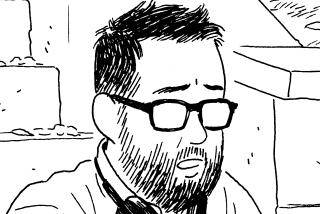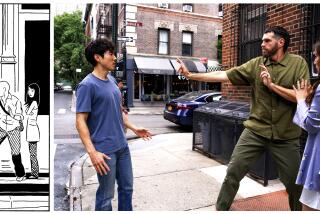Adrian Tomineâs Optic Nerve returns
Adrian Tomineâs Optic Nerve has long been one of my favorite alternative comics â smart, understated and with a subtle yet pointed bite. Originally self-published (Tomine did seven âmini-comicsâ issues beginning in 1991, when he was 17), it was picked up by Drawn & Quarterly in 1995 and has continued to appear, on a semi-regular basis, ever since.
Tomine is probably best known for his work in the New Yorker, but his sensibility is more far-reaching than that. Merging straight realism with an impressionistic sense of narrative, his stories often seem to be offhanded, when, in fact, they are highly structured and defined.
As an example, look at âWinter 2012,â one of three pieces in the newly released Optic Nerve 13 â a one-pager, told by way of 20 small panels, in which Tomine portrays himself as a Luddite, distressed by the indignities of the electronic age.
âWhy would you say that?â he asks the proprietor of an art supply store who has suggested a digital platform. âI came to your âbrick and mortarâ art store to buy paper and youâre proselytizing about computer gadgets?â Itâs a rant but not really, for the joke (as we find out) is on Tomine.
I donât want to give away the ending, but suffice it to say that Tomine uses his alter ego, his character, to highlight the contradictions of his position, poking fun at himself â and, by extension, at all of us. This is how his comics work: seducing us with their seeming indirection, then zeroing in for the kill.
Optic Nerve 13 is built around a long, central story: âGo Owls,â in which a woman meets an older man in a 12-step program and winds up in a relationship that becomes increasingly abusive and fraught. Itâs a solid piece, although at times a little baggy, as Tomine traces the slow dissolution, the claustrophobia, of their bond. Whatâs best about the story is its refusal to moralize, to judge the characters for what they choose (or are compelled) to do. Thus, even as the situation slips into control and occasional violence, we are never on the outside, which makes us, in a certain sense, complicit in what happens on the page.
A similar dynamic fuels âTranslated, From the Japanese,â a love letter from past to present that is among the most beautiful things Tomine has ever done. Framed in large panels â full-page, half-page, quarter-page â this is a story in which nothing happens; we see people, and their interactions, indirectly, if at all.
The text is from a mother to a baby and recounts their journey from Japan to California for a vague reunion with the childâs father, with whom the mother does not live. But the piece takes an unexpected turn in the closing image: a nighttime panorama of San Francisco, with a block of text superimposed over the darkness of the evening sky. âI wonder,â Tomineâs nameless narrator asks, âhow old you are now as you read this. How long have I been gone? Do you remember anything of our time over there, when we were starting a different, unknowable life?â
Here we see the power of Tomineâs work, the use of comics to get at the larger story, to evoke the mysteries of place and time. Where is the mother as she is writing? When does this story take place? That such questions come with no clear answers is, of course, the point: to reflect the unknowability of even the most intimate interactions, the difficulty of defining anything, not least ourselves.
ALSO:
âBefore Watchmenâ: Does âWatchmenâ need a prequel?
Steven T. Seagle, Teddy Kristiansen graphic novel probes âGenius ...
Michael Demsonâs graphic novel of Shelleyâs radical âMask of Anarchyâ
More to Read
Sign up for our Book Club newsletter
Get the latest news, events and more from the Los Angeles Times Book Club, and help us get L.A. reading and talking.
You may occasionally receive promotional content from the Los Angeles Times.








